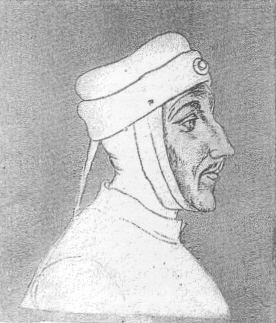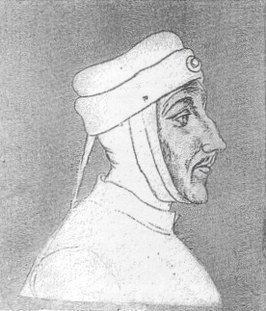Name Louis Count | ||
 | ||
Spouse Margaret of Brabant, Countess of Flanders Children Margaret III, Countess of Flanders Parents Margaret I, Countess of Burgundy, Louis I, Count of Flanders Similar People Margaret III - Countess, Philip the Bold, John the Fearless, John III - Duke of Brabant, Anthony - Duke of Brabant | ||
Louis II of Flanders (Dutch: Lodewijk van Male; French: Louis II de Flandre) (25 October 1330, Male – 30 January 1384, Lille), also known as Louis of Male, a member of the House of Dampierre, was Count of Flanders, Nevers and Rethel from 1346 as well as Count of Artois and Burgundy from 1382 until his death.
Contents

Life
The son of Louis I of Flanders and Margaret I of Burgundy, daughter of king Philip V of France, he was baptised by Bishop Pierre Roger of Arras, the later Pope Clement VI. His father arranged his marriage with Margaret of Brabant, daughter of Duke John III, in the course of the rapprochement to the Imperial Duchy of Brabant.
When his father was killed at the Battle of Crécy against the troops of King Edward III of England in 1346, he inherited the French counties of Flanders, Nevers, and Rethel (as Louis III). In the Anglo-French conflict, the Flanders guilds, depending on the English wool trade, forced Louis to recognize King Edward III as his overlord and arranged an engagement to the daughter of the English king, Isabella. Louis managed to avoid this by fleeing to the court of King Philip VI of France. In 1347 he married Margaret of Brabant, which sparked a revolt in Ghent. Nevertheless, while the Black Death devastated the county and after Louis came to terms with the English king and in 1349 he could return to Flanders to succeed his father.
In 1350 he gained credence by openly refusing to pay homage to the new Valois king John II of France. When his father-in-law Duke John III died without male heirs in 1355, he assumed the title of a Duke of Brabant and moved into the neighbouring duchy, but was unable to wrest it from his sister-in-law Duchess Joanna. Though Louis managed to defeat the Brabantian forces in the Battle of Scheut near Anderlecht (17 August 1356) and capture the cities of Mechelen, Brussels, Antwerp and Leuven, but he was unable to prevail against Joanna, backed by her husband Duke Wenceslaus I of Luxembourg and his mighty brother Emperor Charles IV. By the 1357 Peace of Ath he at least gained the rule over the small Lordship of Mechelen and the thriving city of Antwerp.
Louis tried to govern as a Realpolitiker and continued a policy of neutrality, which kept him in favor with both France and England during the continued conflicts of the Hundred Years' War, initiating a period of stability and relative affluence in Flanders. With regards to his internal policy, his main aim was to prevent the formation of a broad coalition against him, as happened against his father. Except for his last years, he was successful in preventing this.
In 1357 Count Louis II married his seven-year-old daughter Margaret to the minor Duke Philip I of Burgundy, who died from plague four years later. Sole heiress of her father's territories, she was a highly coveted bride courted by both Edmund of Langley, son of King Edward III of England, and Philip the Bold, son of King John II of France and Duke of Burgundy since 1363. After several years of tough bargaining, Count Louis II gave his consent to Philip and his brother King Charles V, in return he received the lordships of Romance Flanders (Lille, Douai, Orchies) and a payment of 200,000 livre tournois. The marriage of Margaret and Philip was celebrated at Saint Bavo Cathedral in Ghent on 19 June 1369.
Though a capable ruler, Louis' lavish lifestyle burdened his county's finances and caused increasing disturbances. However, even in his latter years he managed to get the support of the Bruges citizens against revolting Ghent. The latter years of his rule were nevertheless marked by civil strife. In 1379, he obtained aid from his son-in-law, Duke Philip II of Burgundy, to put down another Ghent revolt. The Flemings again rose in 1382 under Philip van Artevelde and expelled Count Louis from Flanders after the Battle of Beverhoutsveld; however, the influence of Philip procured a French army to relieve him, and the Flemings were decisively defeated at the Battle of Roosebeke. The citizens of Ghent continued to resist (with English aid) until after his death in 1384. His mother Margaret had died two years previously, leaving him the County of Artois and the Imperial Free County of Burgundy (Franche-Comté).
Family
In 1347, he married Margaret of Brabant (1323–1380), daughter of John III, Duke of Brabant. They had three children:
He also left several illegitimate sons, three of whom were killed at the Battle of Nicopolis.
Without any surviving sons, on his death, his extensive possessions in the Low Countries were inherited by his daughter Margaret.
Legacy
The main line of the House of Dampierre, originally only counts of Flanders, had through a clever marriage policy managed to inherit the counties of Nevers (1280) and Rethel (1328). Through Louis' mother, a daughter of King Philip V of France, the counties of Artois and Burgundy (the "Franche Comté") were added to this (1382).
Louis II arranged the marriage of his daughter and heir, Margret, to the duke of Burgundy, Philip the Bold, leading to the subsequent union of Flanders and Burgundy. This provided the core of the Burgundian Netherlands dominions ruled by the House of Valois-Burgundy, which were, together with the Duchy of Burgundy proper, to provide them with a power base to challenge the rule of their cousins, the Valois kings of France in the 15th century.
